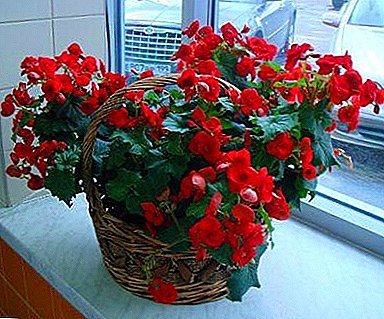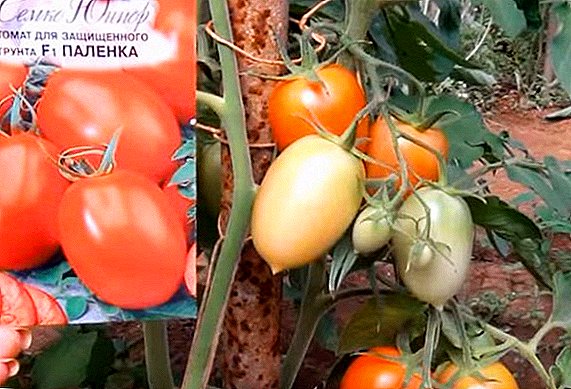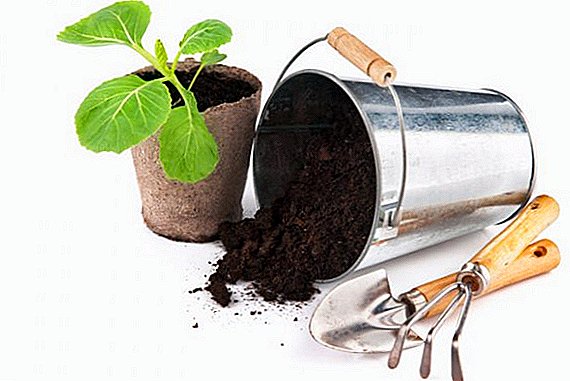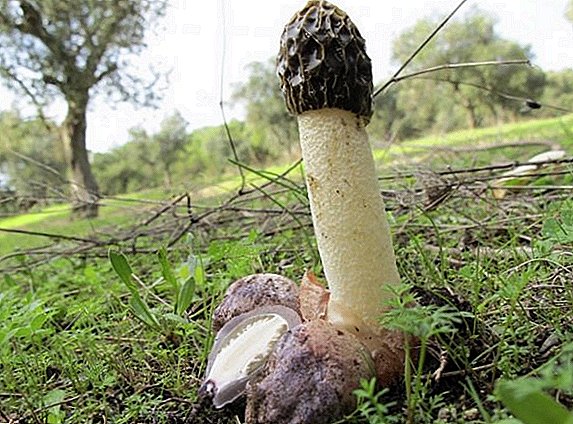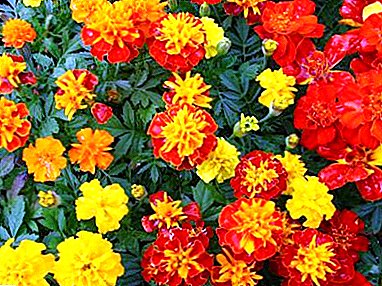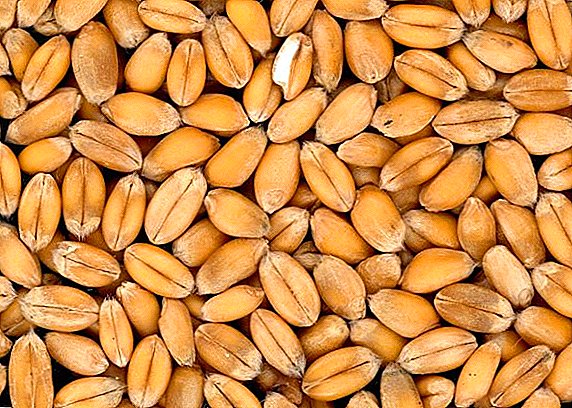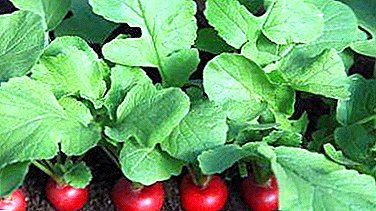 The "breadbasket" which is gaining popularity is a greenhouse, which is distinguished by its small size, ease of operation, and ease of installation.
The "breadbasket" which is gaining popularity is a greenhouse, which is distinguished by its small size, ease of operation, and ease of installation.
You can collect it yourself if you follow simple guidelines.
Description and equipment
The greenhouse has a small size and is designed for growing in the initial stages of seedlings, greenery and root crops. Tall plants usually do not suit this method, since the height of the greenhouse is small, and the shoots will simply begin to rest against the ceiling of the structure.
The dimensions of the frame of the greenhouse "breadbox" - 2.1 × 1.1 × 0.8 m. It provides for the use of cellular polycarbonate, whose thickness is 4 mm.  The frame is calculated so that it can withstand not only wind, but also snow loads. And the coating is made in such a way that you do not have to take it off for the winter.
The frame is calculated so that it can withstand not only wind, but also snow loads. And the coating is made in such a way that you do not have to take it off for the winter.
Did you know? The first hotbeds appeared in ancient Rome and looked like carts on wheels: in the daytime they stood in the sun, and at night they were taken away to warm rooms.The greenhouse frame bought in the store includes:
- Butt - 2 pcs.
- Jumper - 4 pcs.
- Base - 2 pcs.
- The self-tapping screw roofing 4,2 * 19 - 60 pieces.
- Bolt m-5x40 - 12 pcs.
- Bolt m-5x60 - 2 pcs.
- Nut lamb M5 - 14 pcs.
Choosing a place for a greenhouse
It is very important to choose the right installation site, since otherwise there will be no benefit from the greenhouse. Pay attention to all the little things: the location of the cardinal points, nearby objects that can give shade, lighting, etc.
Greenhouses are mainly used in our latitudes for growing seedlings of pepper, tomatoes, eggplants, flowers, cabbage, and cucumbers.
 For the greenhouse "breadbaskets" made of polycarbonate, the best fit the territory, near which there are no other buildings or small buildings. So you can achieve the maximum effect, because a large amount of light will fall on the greenhouse.
For the greenhouse "breadbaskets" made of polycarbonate, the best fit the territory, near which there are no other buildings or small buildings. So you can achieve the maximum effect, because a large amount of light will fall on the greenhouse.The distance to the nearest object that can give a shadow should be at least 5 mhowever, you yourself can count how far a particular structure can cast a shadow.
Important! If there is a septic tank on the plot, then it is better to keep the greenhouse 25 meters away from itSo that the design does not warp over time, it must be placed on a flat place. To check this factor, use the ordinary level.
Installation and installation
So, when you find a sunny place that is not obstructed by other buildings and which is located on a flat area, you can start building a greenhouse in the form of a breadbasket.  The best location for the design is, so that the opening side faces south. This way you will get more heat and light into the case.
The best location for the design is, so that the opening side faces south. This way you will get more heat and light into the case.
Site preparation
You can put the design directly on the ground, but it is best to use the foundation. It can be made of brick or from logs, lumber, etc.
Important! If you use wood to create a foundation, you must first treat it with an antiseptic solution with antifungal properties.Dig a pit, the depth of which will be 70 cm, and the width - the value of the dimensions of your design. Along the entire length of the pit we set the foundation of the future greenhouse. Next, you need to fill in the deepening of any fertilizer - compost, pus, or just dry leaves.
Creating the foundation on which the greenhouse will be located is the most difficult part. By itself, the assembly design is not so complicated.
Frame assembly
The assembly of the frame should be carried out on an already prepared base (for example, on a foundation) or simply on a flat surface. Connect all the base elements that were included. This can be done with screws. Place the lower guides on the base first, then attach the ends to the guides on the opposite side.
All connections occur by inserting a pipe of small cross section into a pipe of large cross section. They fasten to each other with bolts from the kit (M-5x40 mm).
Important! It is better to attach the greenhouse to the prepared base using self-tapping screws 100 mm or 120 mm long.Further, according to the drawings, which are included, we collect the roof. To do this, in turn, you need to put in one common system the end parts, as well as arcs and cross-pieces. Between the ends, which perform the carrier function, insert jumpers.
After installing all these parts form the shape of the future roof. When you put all the parts together and make sure everything is in place, you can tighten the screws.
As you can see, the process is extremely simple: you can assemble a greenhouse using only a screwdriver.
Sheathing
To start trimming the greenhouse “breadbaskets” made of polycarbonate, you need to prepare sheets: cut the polycarbonate sheets using a marker as shown in the diagram in the instructions.
Before cutting them, check all sizes again. You can cut the material and the usual sharply sharpened knife, but it is better to use jigsaw.
Important! The polycarbonate you bought is in film on both sides. It must be removed before you begin to attach the material to the frame.Attach polycarbonate to the prepared base with the help of 4,2 * 19 self-tapping screws supplied. First you need to cover the material of the base frame around the perimeter. Next in line is the inner as well as the outer cap.
The sides of the outer cover should be mounted outside, and on the inside - inside.
Handle fastening
The fittings, in our case it is presented in the form of handles, is fastened last. It is necessary in order to easily open or close the greenhouse.  Attach the handle to the lid with self-tapping screws. Be careful and choose really strong screws, otherwise they can be broken.
Attach the handle to the lid with self-tapping screws. Be careful and choose really strong screws, otherwise they can be broken.
Did you know? In the Middle Ages, gardener Albert Magnus created a beautiful winter garden in Cologne and organized several greenhouses and greenhouses on its territory. Subsequently, he was recognized as a sorcerer because he had violated the natural course of the seasons.Instead, in order not to create additional holes with screws, you can use self-adhesive seals for fastening. It is great for contact with polycarbonate.
Features of operation
The greenhouse is considered universal for the cultivation of various crops. It can grow both flowers and seedlings. However, you should pay attention to the height of the planted plants - this is the only restriction. Most often, early specimens are grown in the breadbasket: radishes, tomatoes, cucumbers.
The collapsible greenhouse is designed for a snow load of no more than 30 kg per square meter. m (about 10 cm of snow), and a folding greenhouse - no more than 45 kg per square meter. m. In the winter, make sure that the cover does not form frost. It will prevent the snow from rolling down itself. If too much rain accumulates, the roof may not withstand the load.  In winter, you can also create additional support from metal or wood to reduce the risk of damage due to heavy loads. If you comply with all these operating conditions, then in the cold season you will not have to remove the cover with polycarbonate. Do not install the structure near buildings from which icicles and other sediments may fall.
In winter, you can also create additional support from metal or wood to reduce the risk of damage due to heavy loads. If you comply with all these operating conditions, then in the cold season you will not have to remove the cover with polycarbonate. Do not install the structure near buildings from which icicles and other sediments may fall.
In the summer, to clean the material, you need to take a damp cloth. This will be quite enough, and the use of additional chemicals is highly undesirable.
The obvious, but repeating rule is that you don’t fire inside. This should not be done near the greenhouse, surrounded by 20 m.
It is often necessary to check how firmly the body is attached to the base. If necessary, fasten it more.
Advantages and disadvantages
The first thing that catches the eye at the sight of the “breadbasket” is its compactness. Due to its small size, it can fit on any site.
Its structure is assembled in such a way that it is possible to work with plants without going inside, which means that it will not be possible to damage them by stepping on them.  In hot weather, both doors can be opened, and thus full ventilation will be provided. Plus, it is convenient to harvest from all sides.
In hot weather, both doors can be opened, and thus full ventilation will be provided. Plus, it is convenient to harvest from all sides.
However, some models cannot fully open. In this case, it will be difficult to care for all plants. But if you create a greenhouse yourself, then you can choose the angle of opening.
The streamlined shape will not allow the snow to linger on the roof in the cold season. It also prevents destructions during strong winds.
The materials from which the greenhouse is made, allow you to retain heat and maintain the optimum temperature inside not only in spring and summer, but also in autumn.
The design has a small weight, that is, if necessary, you can simply move it to another place without even disassembling it.
Polycarbonate - the main material used - has a high light scattering ability, better than glass. Moreover, this material is much stronger than glass. However, compared to the same film, polycarbonate is a more expensive material.  If you construct a greenhouse incorrectly, it will not be durable.
If you construct a greenhouse incorrectly, it will not be durable.
The greenhouse is good for small plants and volumes, for tall crops it is worth considering the installation of greenhouses - Signor Tomato, according to Mitlayder, with an opening roof, with automatic drive, coated with polycarbonate or reinforced film, with the possibility of heating.
"Breadbasket" and "butterfly": the differences
The greenhouse "butterfly" is a popular substitute for the "breadbasket", but they have a number of differences that do not always allow us to consider them interchangeable.
First of all, the "breadbasket" has a lower cost compared to the "butterfly" and many other greenhouses. The described design has less weight, respectively, it is more mobile.
Breadbox displaces the "butterfly" and thanks to a simpler assembly plan. Different ways to open the lid. In the "breadbasket" at any location, they will create a cushion of warm greenhouse air.
If you carefully read the assembly instructions, look at the drawings and drawings, then you will have no questions left, and the process of building the greenhouse will pass quickly and pleasantly.



